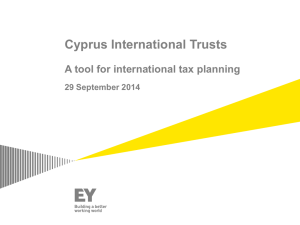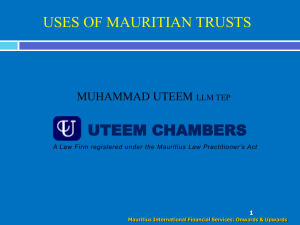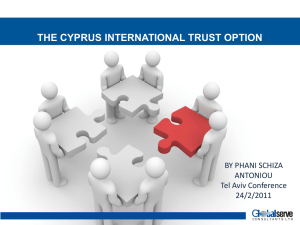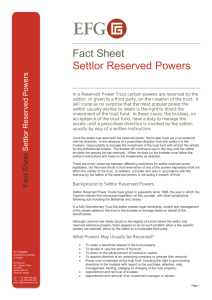GEPC - 2016-1-19 seminar materials from E. Morgan
advertisement
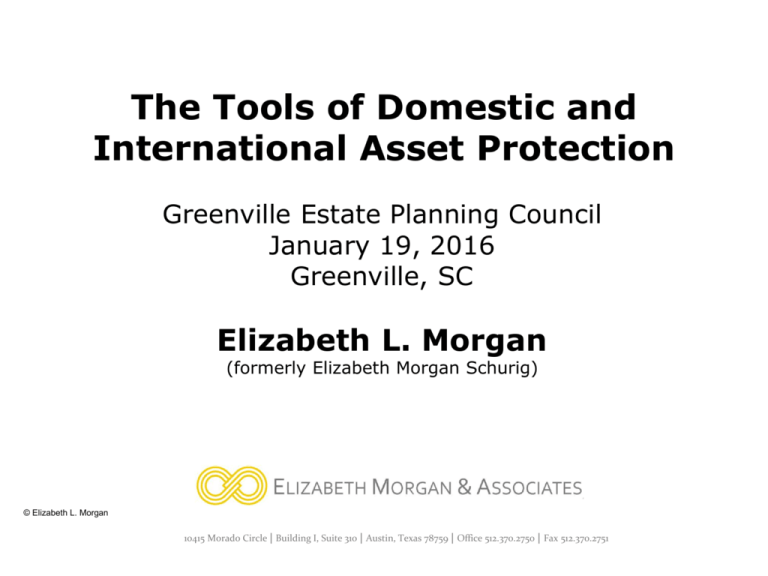
The Tools of Domestic and International Asset Protection Greenville Estate Planning Council January 19, 2016 Greenville, SC Elizabeth L. Morgan (formerly Elizabeth Morgan Schurig) © Elizabeth L. Morgan 10415 Morado Circle | Building I, Suite 310 | Austin, Texas 78759 | Office 512.370.2750 | Fax 512.370.2751 Is It Appropriate for Estate Planning Attorneys to Render Asset Protection Advice? Some commentators suggest that estate planning attorneys have a duty to render asset protection advice Most estate planning advice has an asset protection or wealth preservation component – premarital or post marital agreements – protection against spousal creditors – entity structures – protection against business and other third party creditors – wills & trusts – protection against governmental and other third party creditors – disability documents – protection against unwanted personal results How Do You Know Whether A Client Needs an Asset Protection Vehicle? Everyone needs asset protection to some degree The greater the net worth the more difficult it is to achieve asset protection without a protective trust or entity structure 2 Isn’t Asset Protection Against Public Policy? “[T]he doctrine that the owner of property, in the free exercise of his will in disposing of it, cannot dispose of it, but that the object of his bounty . . . must hold it subject to the debts due his creditors . . . is one which we are not prepared to announce as the doctrine of this court. . . . [E]very State in this Union has passed statutes by which a part of the property of the debtor is exempt from seizure [for] the payment of his debts. . . To property so exempted the creditor has no right to look . . . as a means of payment when his debt is created [and] this court has steadily held that [such exemptions are] invalid as to debts then in existence [but] as to contracts made thereafter, the exemptions [are] valid. This distinction is well founded in the sound and unanswerable reason, that the creditor is neither defrauded nor injured by the application of the law to his case, as he knows, when he parts with the consideration of his debt, that the property so exempt can never be made liable to its payment.”1 1 Nichols v. Eaton, 91 U.S. 716, 725-726 (1875) (Justice Samuel Freeman Miller). 3 United States Legal System The U.S. legal system is different from other Western legal systems in many important ways. Contingency fees allowed Pleadings are protected speech Punitive damages are allowed in civil cases against individuals (rather than only in cases involving corporate products liability) There is no bond requirement, except for appeals There is no loser–pay system 4 The Bankruptcy Abuse Prevention and Consumer Protection Act of 2005 Expands list of nondischargeable consumer debt Amends means test so that, in general, debtors with income greater than state median household income can not get discharge and will be required to reorganize 5 Methods to Achieve Asset Protection Homestead Life Insurance & Annuities Spendthrift Trusts for and Gifts to Descendants CLIENT Spendthrift Trusts for and Gifts to Spouse Limited Partnerships Limited Liability Companies Protective Trusts I. Retirement Plans II. III. 6 Creditor Protection: Fraudulent Transfer Law General rule – A gratuitous transfer of property with the actual or constructive INTENT to avoid creditors is fraudulent and may be set aside by creditors – Any transfer of assets from nonexempt status to exempt status should be tested to assure that it is not a fraudulent transfer Three classes of creditors – Present creditor – solvency analysis – Potential subsequent creditor – badges of fraud – Unknown future creditor 7 Creditor Protection: Fraudulent Transfer Law (cont.) Statute of limitations – Statute of limitations on fraudulent transfer claims in most states is four years from the transfer, or, for existing creditors, within one year of when the transfer could reasonably have been discovered, if later – A bankruptcy trustee can have a fraudulent transfer set aside if the transfer is made within two years of bankruptcy – certain transfers to a self–settled trust or similar device subject to a ten year statute of limitations 8 Solvency Test Total value of assets Less: Liabilities (including contingent) Less: Creditor protected assets (e.g., homestead) Equals: Amount that can be transferred 9 Retirement Plans In most states, unlimited exemption as long as the plan “qualifies” under the Internal Revenue Code ERISA contains anti-alienation provisions Fully protected in bankruptcy if they are exempt from taxation under IRC §§401, 403, 414, 457, or 501(a) Protection for IRAs (under IRC §§408 and 408A) in bankruptcy capped at $1,000,000 adjusted for inflation every three years ($1,245,475 through March 31, 2016 and will be adjusted on April 1, 2016) Rollover amounts bankruptcy cap to IRAs 10 are excluded from Homestead State homestead exemptions based upon either acreage (for example, Florida, Texas, and Kansas) or value (for example, California and Missouri) 2005 Bankruptcy Act Amendment possibly limits equity obtained in homestead during 40 months prior to bankruptcy to $125,000 adjusted for inflation every three years ($155,675 through March 31, 2016 and will be adjusted on April 1, 2016) 11 Life Insurance and Annuities Many states exempt cash value and policy proceeds of life insurance and annuities, even if the insured retains the power to change the beneficiary or the insured or the insured’s estate is a contingent beneficiary In some states this exemption extends to policy proceeds in the hands of the beneficiary and protects those proceeds from the beneficiary’s creditors as well 12 Life Insurance and Annuities: Protective Planning Opportunities Advise the client to move exposed cash into a life insurance or annuity product that is protected under the state statute If the costs of the product are low enough (both the product and tax costs) then the purchase will be both a good investment and a prudent protective device If the product chosen is life insurance rather than an annuity then the investment return inside the product will also avoid income tax 13 Life Insurance and Annuities: Protective Planning Opportunities (cont.) If there is no available cash then consider moving equity out of other assets and into the life insurance or annuity contract 14 Section 529 Plans Some states exempt the assets held in §529 plans if the debtor resides in that state and the plan assets are held by that state’s authorized plan Other states, like Texas, exempt the plan assets regardless of where the assets are held as long as they are held in a state qualified tuition program that meets the requirements of IRC §529 15 Section 529 Plans (cont.) Bankruptcy Code exempts funds in §529 plans but generally limits the exemption to the contribution limits contained in §529 and specifically limits the exemption by completely disallowing contributions made 1 year before bankruptcy and only exempting contributions that do not exceed $5,000 per beneficiary that were made between 2 years and 1 year before bankruptcy In states that allow debtors to choose state rather than federal bankruptcy exemptions §529 plans may be fully exempt in bankruptcy 16 Section 529 Plans: Protective Planning Opportunities Because Section 529 Plan assets can be used to benefit any beneficiary, including the Grantor, the plan assets can be a valuable protected class of assets Move available cash into Section 529 Plans If there is no available cash then consider moving equity out of other assets and into Section 529 Plans 17 What is a Spendthrift Trust? A spendthrift trust is one in which the beneficiary is precluded or restrained from voluntary or involuntary transfers of trust assets. In some states, this includes a prohibition on the ability to pledge as collateral any interest in a trust. The consequences of these types of provisions in trust documents is that the beneficiary’s creditors are precluded from reaching trust assets. In most states, settlors cannot utilize a spendthrift trust to protect assets from the settlor’s creditors. 18 Spendthrift Trusts Primarily statutorily created – not a part of English common law Some states have no spendthrift statutes, but judicial decisions have validated spendthrift provisions (Hawaii, Maryland, Massachusetts, Michigan, Minnesota, and Vermont) Uniform Trust Code 2000 contains provisions validating spendthrift provisions in trusts and addressing rights of settlor’s creditors 19 Trusts for Family Members With Spendthrift Protection Trusts for Descendants – Crummey Trust $14,000 per donee annual exclusion possible – §2503(c) Trust Contributions to trusts for children under age 21 are not gifts of a future interest – Life insurance trust 20 Trusts for Family Members With Spendthrift Protection (cont.) Inter vivos QTIP after partition All income to spouse required, but document can disallow distribution of principal on the happening of some event like divorce Consider funding interest in the family business into an inter vivos QTIP 21 Spendthrift Trusts: Protective Planning Opportunities Draft the trust document to contain a purely discretionary distribution standard rather than an ascertainable standard Consider forming the trust in a jurisdiction that has either repealed the common law rule against perpetuities (for example, Delaware, South Dakota, or Arizona) or has extended the perpetuities period (for example, Alaska – 1,000 years, Florida and Tennessee – 360 years, Nevada – 365 years) 22 Spendthrift Trusts: Protective Planning Opportunities (cont.) Include a provision stating that it is the Settlor’s intention that all property of the trust will be the separate property of the beneficiaries and that no property of the trust will be the communal or marital property of any beneficiary Include provisions allowing the trustee to change the situs or governing law of the trust Include provisions allowing for amendment of the trust document by either the trustee or protector 23 Spendthrift Trusts: Protective Planning Opportunities (cont.) Consider establishing the trust in an asset protection jurisdiction like Nevada or Alaska and allowing the settlor to be a permissible beneficiary (see PLR (200944002)) 24 Advise Clients to Enter Into Premarital and Post Marital Agreements Properly drafted marital agreements create clearly defined property parameters, thereby lessening exposure to each other on divorce In the case of second or successive marriages or other relationships, property agreements will protect children and other interested parties on the death of one of partners to the marriage or other relationship Properly drafted marital agreements can segregate property of the underexposed spouse so that creditors cannot reach them 25 Marital Property Agreements: Protective Planning Opportunities If the creditor concern is third parties rather than spouses, divide assets so that the exposed spouse’s assets consist of exempt assets and so that the unexposed spouse’s assets consist of nonexempt assets Consider unequally severing the assets so that the exposed spouse receives less than the unexposed spouse, and then the unexposed spouse can create an intervivos QTIP for the benefit of the exposed spouse Planning reminder – in community property states, this type of planning causes a loss in the basis step up in the surviving spouse’s property so it must be used cautiously and in a considered fashion. 26 Charitable Planning Certain charitable gifts protect assets as well – Gift of home to a qualified charity with a retained life estate – Bargain sale to a qualified charity – Charitable Lead Trust – Charitable Remainder Trust 27 Limited Partnerships and Limited Liability Companies Aggregate Theory (historical view) – The partnership is not a distinct legal entity separate from the partners – Each partner owns an undivided interest in partnership property making turnover of assets to creditors without impact on non-debtor partners impossible – Charging Order as a remedy protected both the creditor and the non-debtor partners – LLC statutes were modeled on partnership statutes, and so they adopted the partnership statutes’ Charging Order provisions 28 Limited Partnerships and Limited Liability Companies (cont.) Entity Theory (current view) – The partnership is a distinct legal entity separate from its partners – Partners do not own a interest in partnership property; instead, they own an interest in the entity – Under the entity theory, there is no real distinction between partnerships, LLCs, and corporations; thus, it is difficult to argue that Charging Order laws are needed to protect the partners Under the entity theory, the only thing standing in the way of a creditor’s ability to divest a partner of his interest in the entity is the applicable state statute It is interesting to note that Nevada has passed a Charging Order statute applicable to corporations (NRS §78.746) 29 Charging Order A charging order is an order issued by a court pursuant to statute which charges the debtor’s interest in the entity with the amount due to the judgment creditor. Under a charging order, the creditor only gets distributions from the entity to the extent of the debt. Once the debt is extinguished, the charging order is fulfilled. The debtor’s interest in the underlying partnership or company assets is preserved. 30 Foreclosure If a creditor’s lien on a debtor’s interest in a partnership is foreclosed upon, the debtor loses the partnership interest and all of the future benefit in that interest forever (even if that benefit greatly exceeds the debt) including a right to that partner’s pro rata share of the new assets at liquidation (The Uniform Limited Partnership Act (2001) §702(b)). In addition, upon foreclosure, the debtor-partner may also lose the managerial rights afforded him by §702(b) if the other partners consent to expel him in accordance with §601(b)(4). Depending on the relationship with the other partners, this could be incentive for the partner to settle with the creditor instead of forcing a settlement the other way around. 31 Foreclosure (cont.) Uniform Limited Partnership Act (1976) §703 is silent as to foreclosure Uniform Limited Partnership Act (2001) §703 states that a charging order constitutes a lien that can be foreclosed upon by order of the court Uniform Limited Liability Company Act (1996) §504(b) states that a charging order constitutes a lien that can be foreclosed upon by order of the court Uniform Limited Liability Company Act (2006) §503(c) states that a court may order foreclosure upon a showing that distributions under a charging order will not pay the judgment debt within a reasonable time 32 Evolution of Limited Partnerships Man has utilized partnerships to conduct his affairs with others from the beginning of time—evidence of use in Babylon, classical Greece, and Rome.1 General partnerships are simply contracts among individuals who have joined together for a common, usually commercial, purpose. Forerunner of the limited partnership was the commenda by which nobles and clergy, who had the capital but could not directly engage in commercial enterprise, could obtain the benefits of such enterprise without personal liability. The result being that capital that would have otherwise been unavailable to the merchant and trading classes provided the foundation for the elevation of these classes to influential status.2 1 2 Bromberg & Ribstein, “Partnership” Vol. I, §1.02(a) Bromberg & Ribstein, “Partnership” Vol. III, §11.02(a) 33 Evolution of Limited Partnerships (cont.) England codified its common law and mercantile law concerning partnerships in the Partnership Act of 1890 and its Limited Partnership Act in 19073 The U.S. codified its partnership common law in 1914 in the Uniform Partnership Act Early limited partnership law in the U.S. was codified only at the state level and was based on the French Commercial Code of 1807, Sections 23-28, because of its unique provisions avoiding the doctrine of partnership liability to third persons 3 Bromberg & Ribstein, “Partnership” Vol. I, §1.02(b) 34 Evolution of Limited Partnerships (cont.) The first Uniform Limited Partnership Act was codified in 1916 and it reduced the liability exposure of limited partners from that contained in existent state statutes The Revised Uniform Limited Partnership Act (1976) was drafted to address the needs of the large, multi-partner partnerships that were in existence at that time and moved closer to the corporate or entity model than the earlier aggregate model 2001 revision of the Uniform Limited Partnership Act has produced the Uniform Limited Partnership Act (2001) 35 Limited Partnerships General partner manages the entity and is liable for partnership liabilities Limited partners liable for partnership liabilities only to extent of contribution to partnership Helpful planning tools but it is important to undestand their limitations Individuals and/or trusts Individual 99% LP LLC or Corporation 1% GP Limited Partnership Assets / Operations 36 Evolution of Limited Liability Companies Historically a South American concept Wyoming was first state to adopt an LLC Act effective June 20, 1977, which created an entity that provided owners with limited liability from business debts like a corporation but is taxed as a partnership Hamilton Brothers Oil Company formed a Wyoming LLC in 1977 and immediately applied to the IRS for an administrative ruling that it qualified as a partnership for federal income tax purposes IRS granted the ruling on a private basis in 1988 (Rev Rul 88-76) By 1996 every state had enacted an LLC Act Most modeled on partnership statutes because of desire to be taxed as partnership Since IRS issuance of the Check the Box Regulations in 1997, which provide absolute tax certainty with regard to LLCs, partnership characteristics are no longer necessary and are being removed from the state statutes 37 Limited Liability Companies Management of the entity is by outside manager or by members Members liable for company liabilities only to extent of contribution to the company Corporate formalities must be followed Member(s) / Manager(s) 100% LLC/Corporation/ Individual Manager Limited Partnership % Assets / Operations 38 Limited Partnerships and Limited Liability Companies: Protective Planning Opportunities Establish entities in protective jurisdictions Draft operating, company, and/or partnership agreements to restrict transferability of interests Use supermajority provisions to protect control of the entity Transfer control of the entity away from any creditor exposed owner Segregate entity assets into separate entities 39 Entity Structural Options 40 Master Limited Partnership Structure Foreign Trust as Limited Partner Foreign or Domestic LLC as General Partner (or Individually Owned) Potential Future Trusts for Children as Limited Partners Master Limited Partnership Management Agreement These assets could instead be owned by a foreign trust Investment LLC Real Estate LLC Business LLC Intellectual Property Interest LLC Liquid Assets Real Estate Business Intellectual Property Lease 41 License Airplane LLC Centralized Holding Company Structure Owner Owner Management, LLC Holding Company $ LLC LLC License Agreement Trademarks, patents, etc. Operations 42 Decentralized Business Structure $ Grantor Trust Owner/ Settlor Promissory note Owner/ Settlor Foreign Trust Grantor Trust Promissory note Owner Owner $ Owner $ Consulting Agreement Owner $ Operating Company $ LLC Lease Consulting Agreement $ Equipment Owner/ Settlor Foreign Trust Employees Accounts receivable 43 $ Owner/ Settlor Protection for Accounts Receivable Professional firm assets are primarily accounts receivable rather than hard assets To the extent that contractual liens can be created over the accounts receivable, the creditors holding such liens will have priority over subsequent creditor liens or judgments 44 Accounts Receivable Leveraged Transaction Life insurance, annuity, protective entity, or trust Life insurance, annuity, protective entity, or trust $ Owner Loan or distribution $ Owner Professional Service Organization $ Bank Loan Loan or distribution Accounts receivable 45 Collateral Assignment What is a Protective Trust? Definition – The Settlor (the person who transferred assets to the trust) is a beneficiary of the trust; and – The assets that the Settlor transferred to the trust are protected from the claims of the Settlor's creditors 46 Protective Trusts – Two Very Different Options Domestic – Available in Delaware (1997), Alaska (1998), Nevada (1999), Rhode Island (1999), Utah (2003), South Dakota (2005), Tennessee (2007), Wyoming (2007), New Hampshire (2008), Hawaii (2010), and to a lesser extent, Colorado (1994),* Oklahoma (2004), and Missouri (2005), Virginia (2012), Ohio (2013), and Mississippi (2014). Foreign – Available in many foreign countries 47 Vulnerabilities of Domestic Protective Trusts Access to trust assets through U.S. court system U.S. Constitution Availability of punitive damages and attorney’s fees 48 Offshore Protective Trusts Offer Additional Benefits Creditors cannot reach assets through U.S. court system U.S. judgments are not enforceable Cost of pursuing assets offshore is high; loser– pay systems 49 Offshore Protective Trusts Offer Additional Benefits (cont.) Punitive damages and contingent fee contracts not allowed Secrecy and privacy laws prevalent and strictly enforced 50 When To Settle a Protective Trust Before Insolvency – Cannot make a fraudulent transfer under state law or bankruptcy law – a 10–year clawback period may apply in bankruptcy – A gratuitous transfer of property with the actual or constructive INTENT to avoid creditors is fraudulent Before a claim arises – Greater distance in time between transfer and claim against assets results in superior protection 51 Control and Contacts Less Asset Protection More Asset Protection Greater Settlor control Less Settlor control More U.S. contacts Few or no U.S. contacts 52 Typical Protective Trust Structure (Domestic) Wholly discretionary (rather than ascertainable) distribution standard Trustee Settlor Trust Investment Advisor(s) Protector Trustee can add and remove beneficiaries Settlor and family are lifetime beneficiaries Redomiciliation permitted Settlor has limited power of appointment at death 53 Typical Protective Trust Structure (Foreign) Foreign Trustee Settlor Foreign Trust Wholly discretionary (rather than ascertainable) distribution standard Investment Advisor(s) Foreign Custodian Foreign Protector Trustee can add and remove beneficiaries Redomiciliation permitted Settlor and family are lifetime beneficiaries Independent investment advice the norm Settlor has limited power of appointment at death 54 Two Fundamentally Different Offshore Strategies EXPORT THE ASSETS IMPORT THE LAW Foreign Trustee Foreign Trustee Settlor Settlor Foreign Trust Foreign Trust Foreign Protector Foreign Protector Domestic Limited Partnership Foreign Custodian General Partner JURISDICTIONALLY SEVERED JURISDICTIONALLY CONNECTED 55 Check and Balance System Trustee Protector Custodian Bank 56 Representative Trust Structures 57 Nest Egg Trust EXAMPLE Foreign Trustee Settlor Foreign Trust Settlor has $20M total assets Settlor has $10M investment assets Settlor retains $5M of investment assets personally and funds trust with $5M Investment advice to Settlor and to Trustee may be provided by preselected investment advisor Contributions to trust are not subject to gift tax Settlor is subject to income tax on all earnings of the trust Trust assets are includible in settlor’s estate for estate tax purposes Investment Advisor(s) Custodian Foreign Protector $5M 58 Multiple Trusts Settlor $50M Trustee Protector Liechtenstein Trust Trustee Protector $25M $25M Jersey Trust Custodian Custodian Investment Advisor(s) Investment Advisor(s) Trustee Trustee Protector Isle of Man Trust Custodian EXAMPLE Protector $25M Investment Advisor(s) $25M Investment Advisor(s) Bermuda Trust Custodian 59 Settlor has $250M total assets Settlor has $150M investment assets Settlor retains $50M of investment assets personally and funds four trusts with $25M each Domestic or Foreign Dynastic Trust Trustee Settlor Dynastic Trust All of the benefits of a basic wealth protection trust, including Settlor’s retention of beneficial interest and Settlor can make a completed gift (which might use exemption equivalent amount) and allocate GSTT exemption Assets may not be included in Settlor’s estate for federal estate tax purposes Establish in jurisdiction where perpetual trusts are allowed Investment advice to Trustee may be provided by pre-selected investment consultant Investment Advisor(s) Custodian Protector Settlor and family are lifetime beneficiaries Trustor for Settlor’s family arise at Settlor’s death 60 Combination of Trust Structures Settlor Settlor $1M $4M Trustee Foreign Protective Trust Dynastic Trust Protector 20% Member Limited Liability Company Investment Assets 61 80% Member/ Manager Foreign Trustee Foreign Protector Trust Implementation 62 Selection of Jurisdiction Traditional Jurisdictions – Jersey – Guernsey – Liechtenstein – Isle of Man – Bermuda 63 Selection of Jurisdiction (cont.) Established “Asset Protection” Jurisdictions – Cayman Islands – Bahamas – Gibraltar – Belize 64 Selection of Jurisdiction (cont.) New “Asset Protection” Jurisdictions – Cook Islands – Nevis – Turks & Caicos – Mauritius – Niue – St. Lucia 65 Liechtenstein Loser–pay (and deposit 10–15% of asserted damages with court before filing suit) No punitive damages No contingent fee contracts Must engage Liechtenstein counsel 66 Liechtenstein (cont.) No enforcement of foreign judgments (except Swiss and Austrian judgments) Legal proceedings conducted in German No “specific” asset protection laws 67 Cook Islands Highly “specific” asset protection laws Fraudulent transfer – Burden on creditor to prove beyond a reasonable doubt that: transferor specifically intended to defraud creditorclaimant; and transferor rendered insolvent by transfer 68 Cook Islands (cont.) Statute of limitations – No transfer made more than two years before cause of action accrued is fraudulent – Creditor must sue within one year after transfer to Cook Islands trust 69 Negotiation of Fees Start-up On-going – Legal fees – Legal fees – Trustee fees – Accounting fees – Foreign taxes/duties – Trustee fees – Protector fees – Custodial fees – Money management fees – Foreign taxes 70 Due Diligence (Standard for all Jurisdictions) Certified copies of settlor’s passport and residential utility bill – In some jurisdictions, the same is required of all current beneficiaries Letter of recommendation from attorney or bank Professional curriculum vitae for settlor, if applicable Statement as to source of wealth Financial statement (including current and contingent liabilities) accompanying an affidavit of solvency 71 Additional Due Diligence (Varies by Jurisdiction) Due diligence forms and additional requirements vary from jurisdiction to jurisdiction, but typically include: – Personal details for settlor and settlor’s immediate family – Current occupation of settlor and business/career history (source of wealth) – Information on proposed trust structure, including name of trust, beneficiaries, protector, etc – Information on proposed trust funding, including source of funds, type and amount of assets to be contributed, and plans for future investment and handling of trust assets 72 Preparation of Documents Trust instrument Affidavit regarding financial condition Trustee and protector fee agreement letters Form SS-4: Application for Employer Identification Number Authorization of agent (IRS) Account opening documents (including Forms W9 and W-8IMY - withholding certificates) 73 Tax Considerations and Reporting Requirements 74 Income Taxation – Typically Tax Neutral Income Tax: taxed as Grantor Trust if Settlor and at least one beneficiary are U.S. persons (IRC §679) – All items of income, deduction, and credit flow through to Grantor 75 Capital Gain Taxation: IRC §684 Incomplete Gift Trust: no tax on transfer of appreciated assets when trust is a Grantor Trust; no tax on appreciated assets at Grantor’s death. Completed Gift Trust: no tax on transfer of appreciated assets when trust is a Grantor Trust; but tax is imposed on appreciated assets at Grantor’s death. 76 Gift Taxation – Typically Tax Neutral Gift Tax: gifts can be either complete (gift tax due on transfers) or incomplete (no gift tax due on transfers); incomplete gift requires retention by grantor of special power of appointment 77 Estate Taxation – Typically Tax Neutral Estate Tax: assets not includible in estate for federal estate tax purposes if there was a completed gift made at time of transfer, but are included if there was an incomplete gift made at time of transfer 78 Primary Foreign Trust Filing Requirements Form 3520: Annual Return to Report Transactions with Foreign Trusts Form 3520-A: Annual Information Return of Foreign Trust with U.S. Owner Form 1041: U.S. Income Tax Return for Estates and Trusts (with Grantor Trust Information Letter attached) Form TD F 90-221.1: Report of Foreign Bank Accounts Form 8938: Statement of Foreign Financial Assets 79 Primary Foreign Trust Filing Requirements (cont.) Form 8858: Information Return of U.S. Persons with respect to Foreign Disregarded Entities TDF 90-22.1: Report Financial Accounts of Foreign Bank and Form 709: United States Gift (and GenerationSkipping Transfer) Tax Return 80



